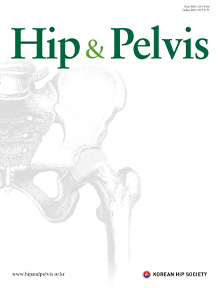Quick links
Related article in
-
Case ReportSeptember 30, 2015
 0
0
 70
70
 17
17

Fracture of Fully-coated Femoral Stem after Primary Total Hip Arthroplasty for Nonunion of Intertrochanteric Fracture: A Case Report
Young Soo Chun, MD, Hyung Suk Juh, MD, Yoon Je Cho, MD*, Kee Hyung Rhyu, MD
Hip Pelvis 2015; 27(3): 179-182AbstractFemoral stem fracture is an uncommon reason for the failure of total hip arthroplasty, with only 16 cases of fully coated stem fractures reported to date. Here we report a case in which a fully coated primary femoral stem fracture occurred after conversion to total hip arthroplasty for the non-union of an intertrochanteric fracture of the femur. Metallurgic evaluation of the etiology and mechanism revealed that the fracture was initiated by fatigue-related failure and completed by ductile failure on the posterior side of the fracture. Considering the recent trend of treating an intertrochanteric fracture with hip arthroplasty, possible stem failure should be considered, since most patients will have at least one of the known risk factors for stem fracture. -
Review ArticleSeptember 30, 2017
 0
0
 98
98
 32
32

Recent Updates of the Diagnosis and Prevention of Venous Thromboembolism in Patients with a Hip Fracture
Won Chul Shin, MD, PhD, Sang Min Lee, MD, Kuen Tak Suh, MD, PhD
Hip Pelvis 2017; 29(3): 159-167AbstractVenous thromboembolism (VTE) is a potentially fatal complication that is relatively common after hip surgery. Since patients with a hip fracture have a higher risk of preoperative VTE due to an inability to ambulate after injury and aggravation of underlying age-related conditions, it may be difficult to effectively prevent VTE using only conventional approaches. Very few studies have been published reporting on the prevalence and prevention of VTE in patients with a hip fracture compared to those with hip arthroplasty. For this reason, we aimed to share recent updates on the diagnosis and prevention of VTE in patients with a hip fracture. Preoperative screening tests to diagnose VTE need to be performed more actively following hip fracture and indirect multidetector computed tomography venography is considered the most effective test for this purpose. As the risk of VTE appears to increase with time following a hip fracture, preventive measures should be taken as soon as possible in patients with a hip fracture. A wide variety of mechanical and pharmacological options are available for prophylaxis. When considering patient compliance and preventive impact, intermittent pneumatic compression devices and foot pumps are recommended as mechanical modalities. Of the available preventive medications for patients with a hip fracture, low molecular weight heparin seems to be the most appropriate option because of its short half-life and fast onset of action. Surgery should be performed as soon as possible in patients with hip fractures, and we recommend mechanical and pharmacological methods as active interventions immediately after injury to prevent VTE. -
Original ArticleJune 1, 2008
 0
0
 63
63
 17
17
Cementless Bipolar Hemiarthroplasty for Hip Fracture in Patients More than Seventy Years Old with Osteoporosis
Sung Kwan Hwang, M.D. Ph.D., Young Jun Shim, M.D., Jea Heung Yang, M.D., Dong Hyon Kang, M.D.
J Korean Hip Soc 2008; 20(2): 131-137AbstractPurpose: This study evaluated the effectiveness of bipolar hemiarthroplasty with a cementless femoral stem for hip fractures in patients older than 70 years with osteoporosis.
Materials and Methods: This study examined 84 hips with osteoporosis that are available to follow up of more than 2 years, between July 1997 and May 2006. The clinical evaluation was carried out using the Koval classification before the fracture and at the last follow-up, and the Harris hip score at the last follow up. The radiological evaluation was carried out using the plain radiographs.
Results: The average follow up period was 31.4 months. The Koval classification was as follows: recovery to the condition before the fracture in 25 cases (30.1%), degradation by 1 class in 56 cases (67.5%) and degradation by 2 classes in 2 cases (2.4%). The Harris hip score was 82.7 points at the last follow-up. One case (1.2%) showed cortical hypertrophy and all cases showed stable insertion of the femoral stem.
Conclusion: Bipolar hemiarthroplasty with a cementless femoral stem is effective and satisfactory, both clinically and radiologically, for the treatment of elderly patients with fractures around the hip.
- 1

Vol.36 No.1
Mar 01, 2024, pp. 1~75
Most Keyword
?
What is Most Keyword?
- It is most registrated keyword in articles at this journal during for 2 years.
Most View
-
Pathophysiology and Treatment of Gout Arthritis; including Gout Arthritis of Hip Joint: A Literature Review
Yonghan Cha, MD
Hip Pelvis 2024; 36(1): 1-11 , Jongwon Lee, MD
, Jongwon Lee, MD  , Wonsik Choy, MD
, Wonsik Choy, MD  , Jae Sun Lee, PhD*,†
, Jae Sun Lee, PhD*,†  , Hyun Hee Lee, MD‡
, Hyun Hee Lee, MD‡  , Dong-Sik Chae, MD‡
, Dong-Sik Chae, MD‡ 
-
Treatment of Osteoporosis after Hip Fracture: Survey of the Korean Hip Society
Jung-Wee Park, MD
Hip Pelvis 2024; 36(1): 62-69 , Je-Hyun Yoo, MD*
, Je-Hyun Yoo, MD*  , Young-Kyun Lee, MD
, Young-Kyun Lee, MD  , Jong-Seok Park, MD†
, Jong-Seok Park, MD†  , Ye-Yeon Won, MD‡
, Ye-Yeon Won, MD‡ 
Editorial Office
Laboratory tests performed in hip fracture patients. CTX: carboxy-terminal telopeptide of collagen I, PTH: parathyroid hormone, P1NP: procollagen type I N propeptide, U/A: urinalysis.|@|~(^,^)~|@|First-line treatment option for osteoporosis in hip fracture patients. BP: bisphosphonate, PTH: parathyroid hormone, SERM: selective estrogen receptor modulator.|@|~(^,^)~|@|Osteoporosis medication in patients with rebound phenomenon after cessation of denosumab. Ca+Vit. D: calcium and vitamin D, PTH: parathyroid hormone, SERM: selective estrogen receptor modulator.|@|~(^,^)~|@|The most important recognized factor for atypical femoral fracture.|@|~(^,^)~|@|Preferred osteoporosis medications after cessation of bisphosphonate in patients with atypical femoral fracture. PTH: parathyroid hormone, Ca+Vit. D: calcium and vitamin D, SERM: selective estrogen receptor modulator.|@|~(^,^)~|@|Preferred osteoporosis medications in patients with high-risk of atypical femoral fracture. Ca+Vit. D: calcium and vitamin D, SERM: selective estrogen receptor modulator, PTH: parathyroid hormone.
Hip Pelvis 2024;36:62~69 https://doi.org/10.5371/hp.2024.36.1.62
© H&P
© 2024. The Korean Hip Society. Powered by INFOrang Co., Ltd




 Cite
Cite PDF
PDF



